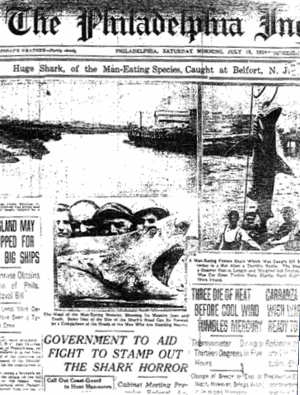Jersey Shore shark attacks of 1916 facts for kids
The Jersey Shore shark attacks of 1916 were a scary series of shark attacks that happened along the coast of New Jersey, in the United States. These attacks took place between July 1 and July 12, 1916. Four people sadly died, and one person was injured. For many years, experts have wondered what kind of shark was responsible. The great white shark and the bull shark are the two most likely suspects. These events happened during a very hot summer and a polio sickness outbreak. Because of this, many people were visiting the beaches of the Jersey Shore to cool off.

Before 1916, most people thought sharks were harmless. But after these attacks, public opinion changed completely. Sharks quickly became seen as dangerous, fearless killers.
The attacks caused a wave of panic. People started hunting sharks to try and get rid of the "man-eating" sharks. They also wanted to protect the beaches and the towns that relied on visitors. Some beach towns even put up steel nets in the water to keep swimmers safe.
Before 1916, scientists didn't know much about sharks. The attacks made experts rethink what they believed about sharks and how they behaved. Shark attacks on the Atlantic Coast of the United States were very rare, especially outside warmer states like Florida or Georgia. Experts now think that more sharks and more people in the water at the same time led to the 1916 attacks.
The shark attacks were even talked about in the government. The United States House of Representatives held meetings about public safety. Even President of the United States Woodrow Wilson was involved.
The Jersey Shore attacks quickly became a big part of American popular culture. Sharks started appearing in caricatures (funny drawings) in newspapers, showing them as a symbol of danger. The attacks have also been featured in many TV shows and documentaries. You can find shows about them on channels like the History Channel, National Geographic Channel, and Discovery Channel.
Images for kids
-
Philadelphia Inquirer coverage of the attacks at Matawan, with portraits of Stanley Fisher (bottom right) and Lester Stilwell
-
German American Michael Schleisser and the great white shark caught in Raritan Bay thought to be the "Jersey man-eater", as seen in the Bronx Home News
-
Leading scientists of the American Museum of Natural History in New York City debated the threat posed by sharks before and after the 1916 Jersey Shore attacks
See also
 In Spanish: Ola de ataques de tiburón de Nueva Jersey de 1916 para niños
In Spanish: Ola de ataques de tiburón de Nueva Jersey de 1916 para niños





